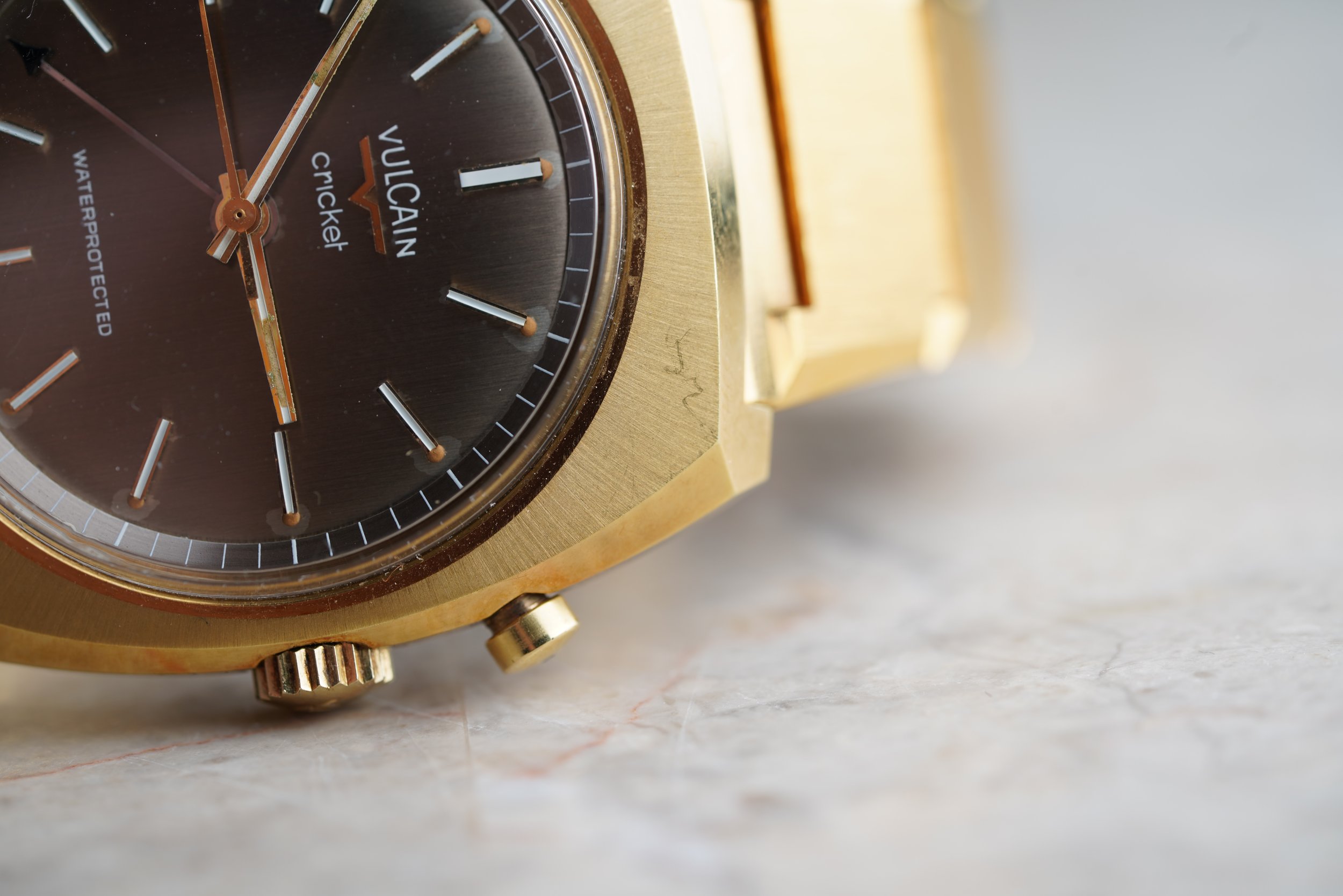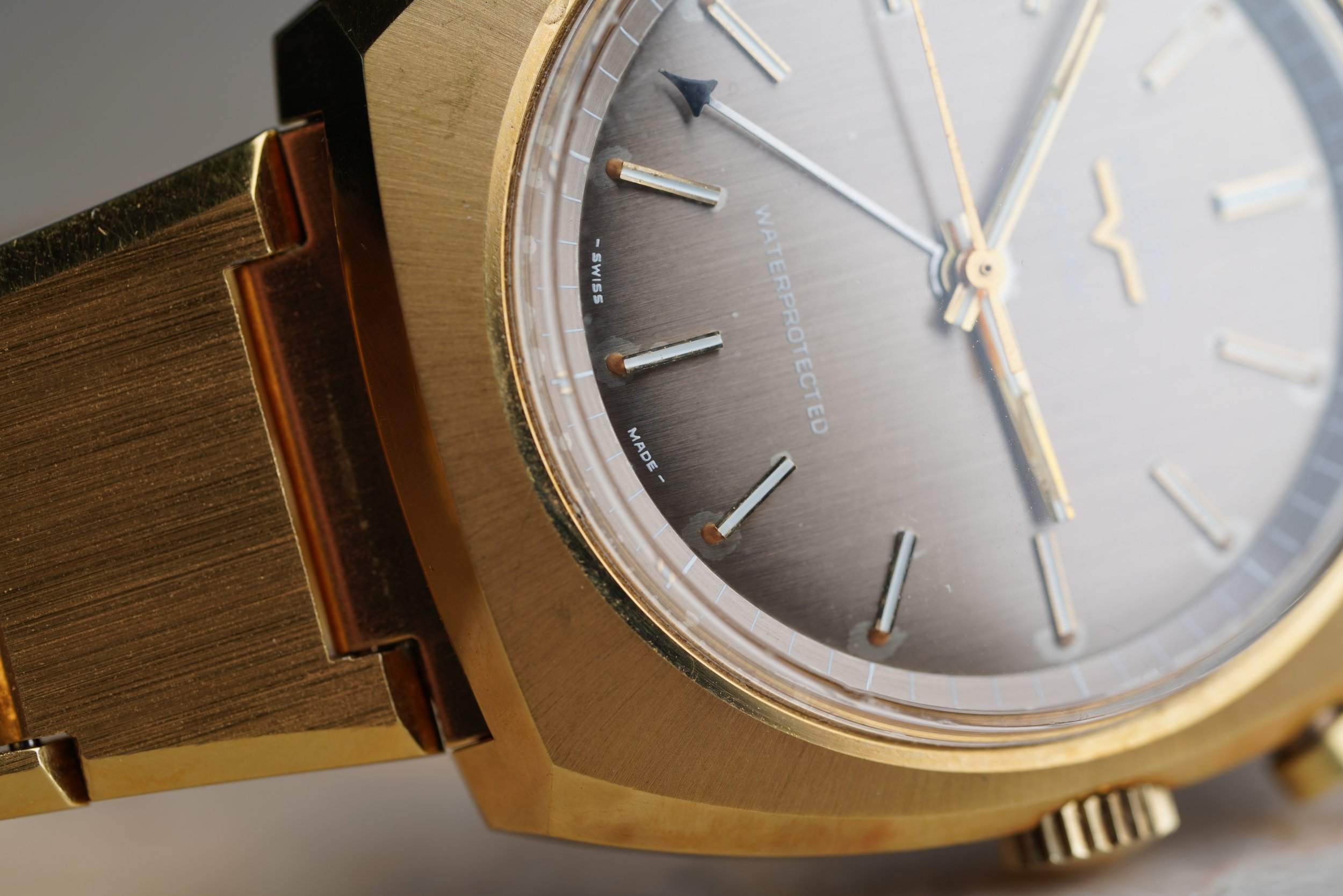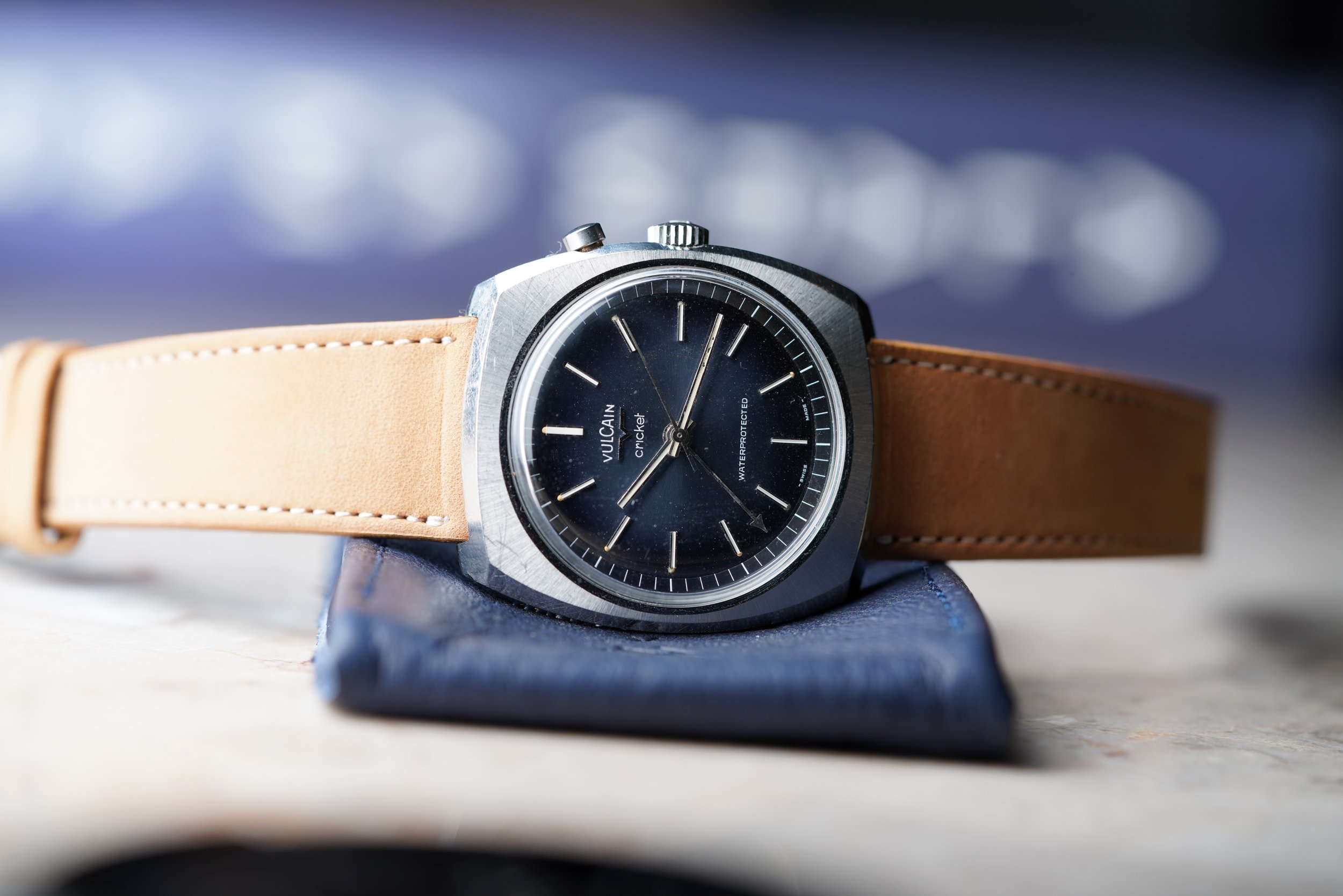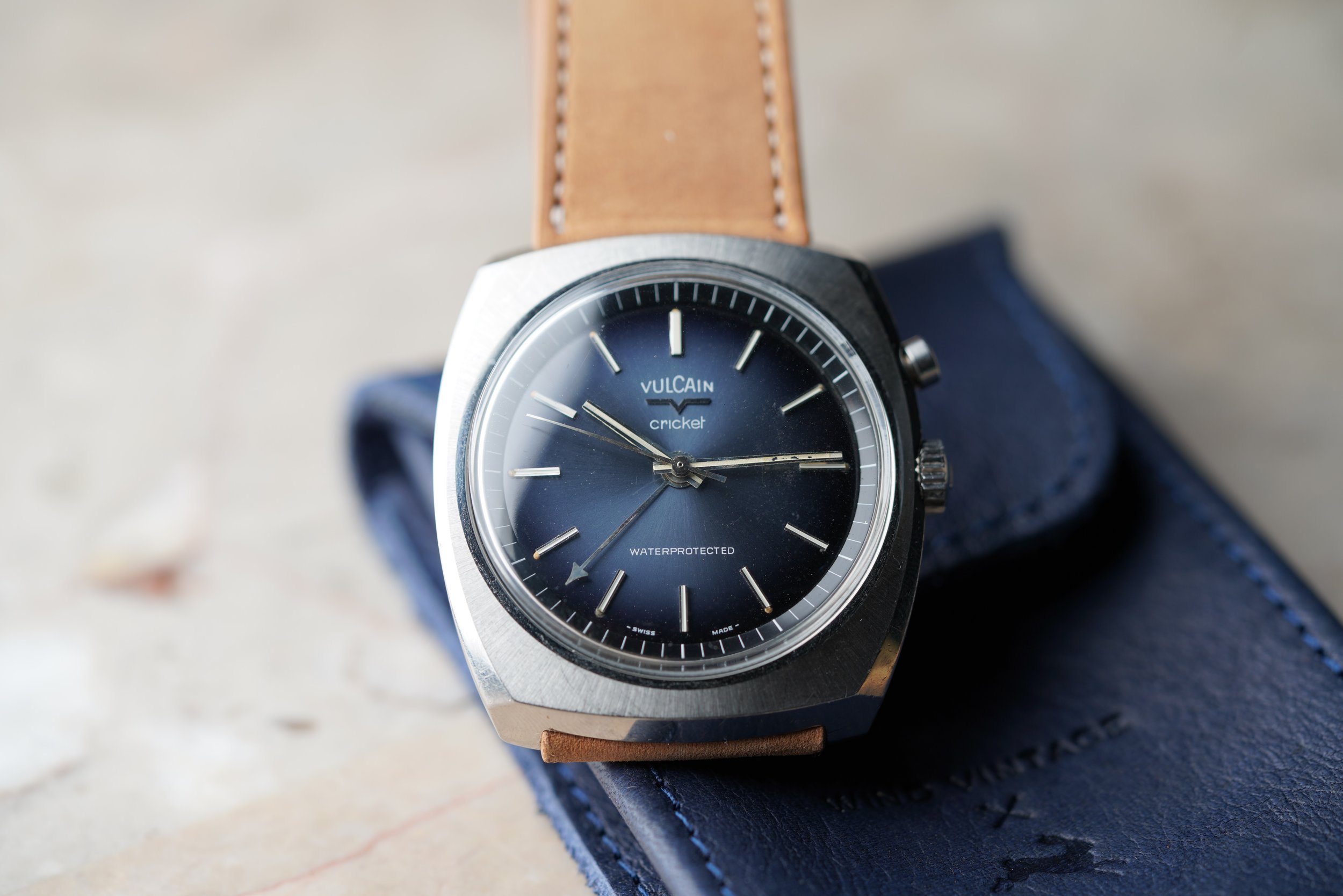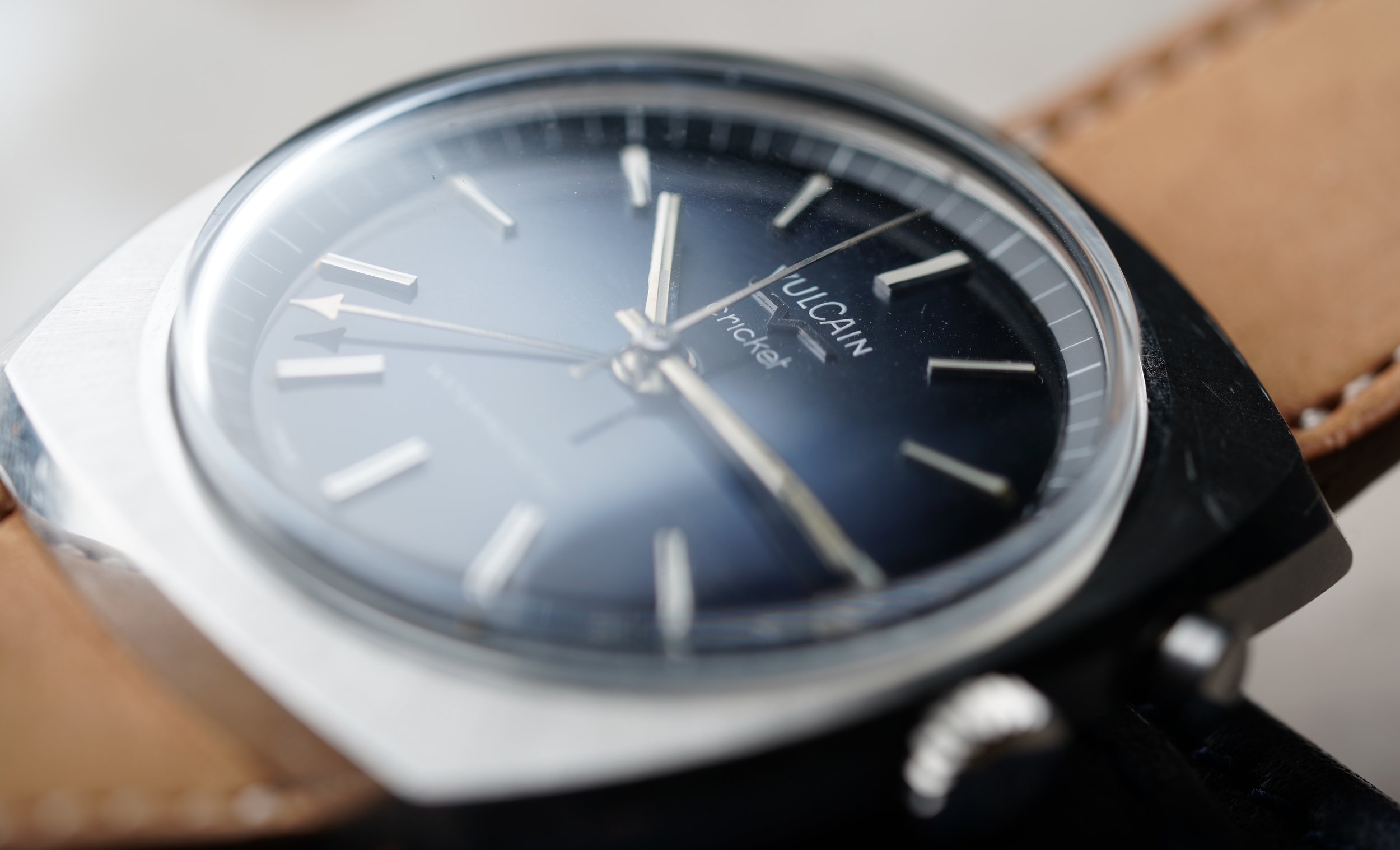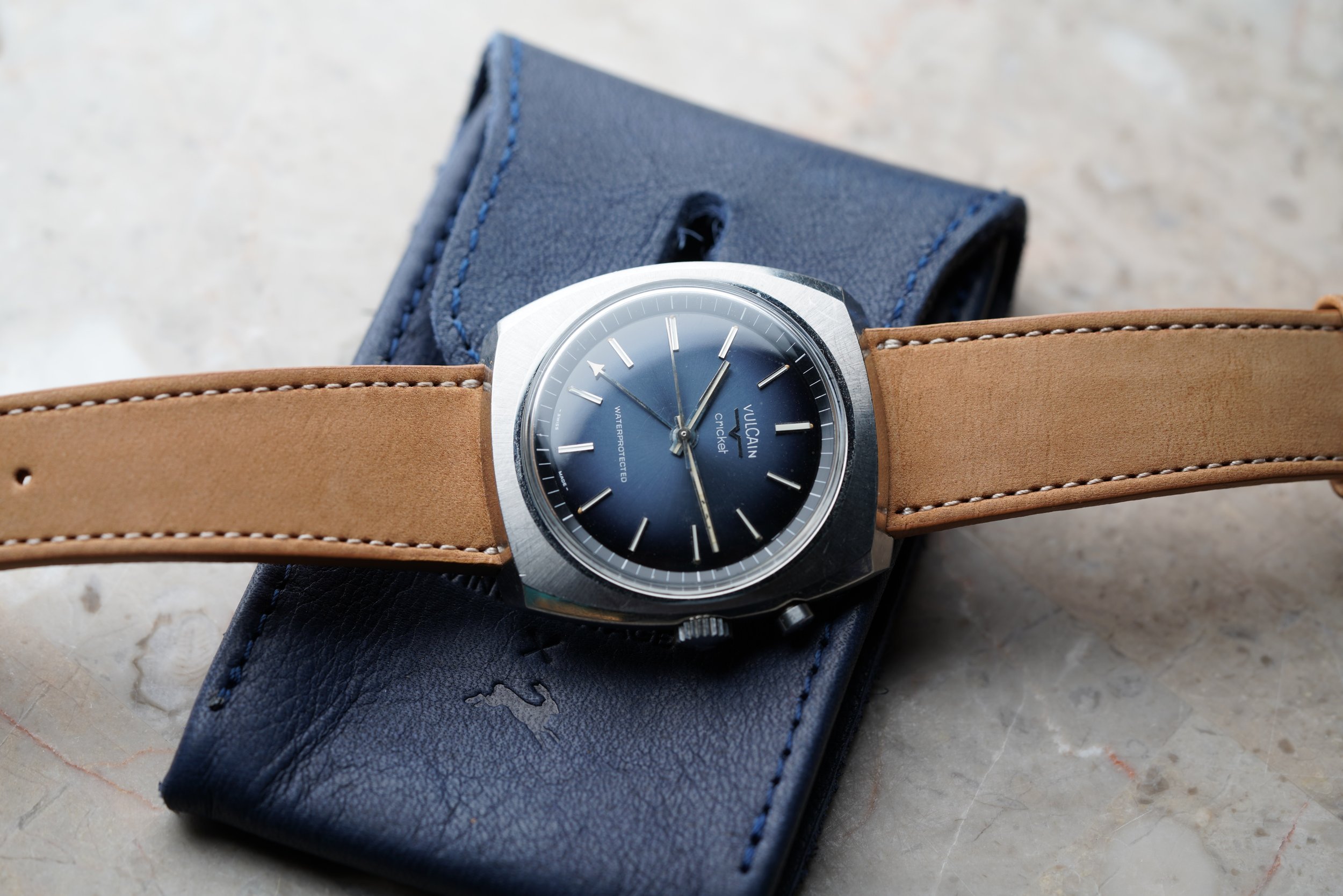Undervalued: Oversized Vulcain Crickets
By Charlie Dunne
By Charlie Dunne
It’s not uncommon that Eric Wind and I find vintage Vulcain Crickets with the calibre 120 (or the evolution of it in the MSR S2) which have spent decades unaltered, sometimes not having been opened since leaving the factory originally. Amazingly, they often continue to keep excellent time with the alarm still operating correctly. In contrast, we have seen far too many “high-end” timepieces that have the unfortunate reputation for needing to be returned to their factory of origin many times within a short span for servicing. Thankfully, not all vintage watches are “highly sensitive” and many, such as vintage Vulcain Crickets, were built with more durability than watches today. Vintage Vulcain Crickets are true workhorses.
Much of the attention surrounding the Vulcain Cricket focuses on the earliest models. Whether the “OG” Crickets or subsequent 2nd series cases (such as the reference 304001), the classic dimensions and groundbreaking calibre 120 helped define a special period in alarm watches. Like many watches from the 1970s, the designs would evolve into a more broad and aggressive appearance. Even with my affinity for the Cricket, I’ll admit it took me some time to appreciate the later models.
While the early iterations used cases made by Manufacture Favre & Perret SA, Vulcain would evolve their product line in the 1950s and 1960s as consumer standards demanded more water-resistant watches. The brand would usher in “Waterprotected” models through the renowned case manufacturer Ervin Piquerez (EPSA). EPSA’s reputation, albeit earned later than the Rolex Oyster, is closely associated with their impermeable bayonet case designs. A renaissance man of his era, Piquerez would file 200 patents and register 8,000 designs over the course of his career. Just about every manufacturer would commission EPSA throughout 50s-70s to compete with the offerings from Rolex. Incredibly, one of the greatest case manufacturer would achieve this with a staff of only 160 employees by the early 1970s. Whether Breitling Cosmonautes, the Vulcain Nautical Cricket, the Jaeger-LeCoultre Polaris, Heuer’s Carrera and Monaco, or Enicar’s Sherpa Graph and Ultradive, Piquerez be integrally involved in many highly-coveted vintage sports watches.
Image credit: Europa Star (ASIA | 1971 | ISSUE #122)
“On 13th January of this year, Mr. Ervin Piquerez, an industrialist from Bassecourt, died in a Basle nursing-home at the age of 62. With him, the Swiss horological industry loses an outstanding pioneer who contributed in no small way to the prodigious development of watch case manu facture in the Jura. Mr. Erwin Piquerez who was the descendant of a long line of industrialists of this branch of the trade (his grandfather, Camille Piquerez, set up a watch case factory at St. Ursanne in 1880) began his career making bicycles with his brother, Camille. In 1935, he married one of the daughters of Mr. Léon Frésard. After working for some time with his father-in- law at enlarging the family business, Mr. Ervin Piquerez took over a watch case factory on his own account, thus renewing the trade of his forbears.
The beginnings were modest and he encountered every kind of difficulty. But his courage and tenacity won the day and his inventive genius stood him in good stead when he set up what was to become the foremost Swiss factory making watch cases. He built it up stage by stage with a chosen few. He employed 10 people in 1939 but the factory today has a staff of 160.
Thus, in twenty-five years, Mr. Erwin Piquerez did pioneer work and revolutionized manufacturing methods and traditional watch case design. He brought out 200 patents and registered 8000 designs. Mr. Erwin Piquerez stood out in a very special way because parallel to this prodigious technical development, he succeeded in humanizing working conditions by setting up social institutions that were much appreciated by his employees. He was also a patron of the arts. Mr. Ervin Piquerez encouraged many contemporary artists by purchasing some of their more important work which is a testimony to his good taste and wish to foster the arts.”
EPSA advertisement circa 1955. Image credit: Europa Star.
While EPSA was known for their innovative compressor cases, the models from more renowned brands are not inexpensive. To stay on track with the theme of this article series on “undervalued” timepieces, we return to the specific model at hand: Oversized Vulcain Crickets.
Vulcain Cricket reference S2312B
The 1960s and 1970s shone a light on a fantastic new style for the Vulcain Cricket. Particularly in the bulkier case references such as the reference S2326B and S2926B. The massive case measures 41mm lug-to-lug, with a diameter of 38mm (excluding the crown). These models will exclusively feature the calibre MSR S2, a manual wind alarm calibre that operates in the same manner as the calibre 120. For many of the Crickets sold in the United States, the movements will feature US import codes (BOL, NOU, OYT, PWP, VOH or ZXW).
Seen above is a gold-plated reference S2926B. The watch features a vertically brushed brown dial. With these light brown dials, oftentimes the surrounding area of the hour markers can slightly fade appearing to show the initial zapon treatment of the dial to transition into a lighter cream color, perhaps related to a reaction from the luminous material (tritium in this case). The watch is seen on its original gold-plated bracelet, which features a vertical brushing to match the dial.
Vulcain Cricket ref. S2926B featured in 1974 trade publication. Image credit: Europa Star
The above example features a brown fumé dial which has an explosive appearance in person. Within the steel examples, these dials are tremendously complemented by the radial brushing of the bezel. The watch is paired on a beautiful light blue strap to give it an attractive and casual look.
A vintage Vulcain Cricket buckle from 1970s which was sold on the reference S2926B
Vulcain Cricket reference S2312B
Vulcain Cricket reference S2326B
The above example features one of the most beautiful dial variants for the model - a degrède (or blue vignette dial). It also has a thin white “Vulcain” font, which is less compact when compared to the earliest models. The watch is paired with a tan Wind Vintage strap by Nick Gabarro, which gives it a mammoth presence even on wrists as large a 8.5 inches.
Unlike in the degrède dial, these vertically brushed dials tend to have a bit more character developed around the area of the luminous plots and hour markers. This is likely a result of the tritium, and hour markers, having a reaction to the galvanized surface of the dial. While the brown dial examples often show a discoloration with a slightly lighter color, the blue examples can create a very striking effect mirroring a flame as seen in the blue dial example above. Complemented by a brown or yellow leather strap, these can have an insanely cool appearance that will keep your eyes glued to the dial. This is sometimes seen on blue Patek Philippe Ellipse watches and other metallic blue dials from the 1960s and 1970s, including the Heuer Skipper reference 7754 (also known as the “Skipperera”) and some Rolex Date and Datejust models. Sometimes people call this effect on the blue dial “vermicelli” like worms on the dial, also referencing the famous Italian pasta.
Reference S2326B
Similar to the previous degrède reference S2326B, the above example features a more muted blue dial with a vertical brushed surface. It is a super special example in the fact that it features an extremely rare steel bracelet original to the watch. There are no initials or details for these bracelets, but they are extremely comfortable and add a great aesthetic to the watch, somewhat resembling a knight and his armor.
While the brand has released modern interpretations of the Cricket in larger dimensions over recent decades, the vintage examples have proven to maintain superior quality and desirability. Models such as Cricket Nauticals and Jumbo Crickets remain the most desirable Crickets in the world. Although it is uncertain whether the above examples will rise in price, there is a great amount to appreciate within these oversized, cushion-case Crickets and we strongly recommend you get your hands on them if you have the chance.










